Can You Add Filefish to a Reef Tank?
By Scott W. Michael ... courtesy to : www.fishchannel.com
There are five families of fish that comprise the bulk of coral reef fish communities. These are, in order from most well represented to the least: gobies, wrasses, groupers, damsels and cardinalfish. Although these may be the most abundant groups on coral reefs and some of the most popular fish in aquarium stores, there are many other families that are very worthy of note.
One family often overlooked by aquarists, with some very interesting species, is the filefish clan (family Monacanthidae).
The filefish, which are considered to be some of the most highly "advanced” bony fish, belong to a group of fish known as the order Tetraodontiformes (formerly known as the order Plectognathi). This group also includes some very popular aquarium families: puffers, porcupinefish and triggerfish.
Meet the Filefish Family
There are 31 genera in the family. The ones most often seen in the aquarium trade are Acreichthys, Aluterus, Amanses, Cantherhines, Chaetoderma, Monacanthus, Oxymonacanthus, Paraluteres, Pervagor and Stephanolepis — with about 95 species.
The mimic filefish (Paraluteres prionurus) derives protection from being almost identical in color to the toxic saddled toby (Canthigaster valentini). Photo by Scott W. Michael
Filefish :
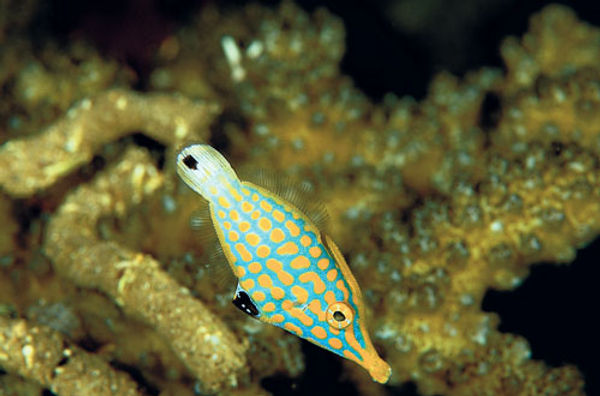
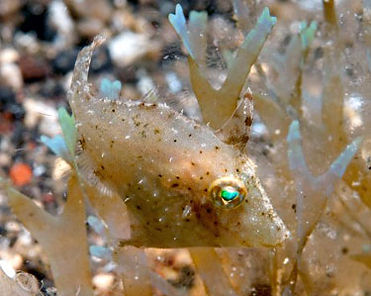
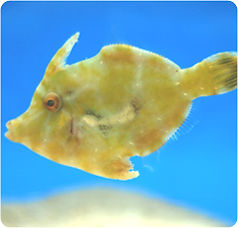

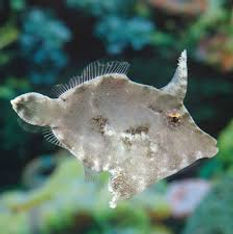
The filefish have two dorsal fins, the first usually having two stout spines (a few have one). Like their cousins the triggerfish, the pelvic fins are lacking; instead there is an extension of the pelvic bone (known as the pelvic rudiment) that has a "spinous” knob on its end (some species lack this structure) and skin attached to it. In some filefish, this bone is moveable and has an attached skin flap that is erected when they display toward a rival.
When filefish swim, they propel themselves by undulating the soft dorsal and anal fins. As a result, they are adequate but not strong swimmers, and they rely more on coloration/pattern and hiding to avoid being eaten. The filefish have nonoverlapping scales that have spicules (raised points) protruding from the center of each scale. In Australia, the name "leatherjackets” has been applied to the monacanthids because of the sandpaperlike texture. Many filefish have a patch of enlarged spicules just in front of the tail; these are larger on male specimens. Most members of the family fall in the 4- to 12-inch range, though there is one "giant” that reaches more than 3 feet in length.
When it comes to pigmentation, some of the filefish are brightly colored, while many exhibit more subdued earth tones that facilitate their camouflage (they may even change their hue to better blend with the background). Some have filaments on the body to help break up the body outline (these weedlike extensions are most well-developed in the tasseled filefish, ).
Filefish Lifestyles
Although there are a number of filefish species found in coral reef ecosystems, they are by no means restricted in their distribution to tropical seas or coral reefs. In fact, there are just as many species that make their homes on warm temperate rocky reefs.

The sea grass filefish (Acreichthys tomentosus) is often employed to clear the aquarium of pestilent anemone species, such as Aiptasia and Anemonia. Photo by Scott W. Michael
Some species regularly associate with floating algae and/or debris. In many of these filefish species, it is the juveniles that associate with flotsam. For example, I have seen groups (numbering in the dozens) of young scrawled filefish (Aluterus scriptus) hanging out under floating plant material, trash and Sargassum algae. The inflator filefish (Brachaluteres spp.) often live among soft coral "trees” and may even grip a polyp in their jaws when they sleep at night to maintain their position among the branches. The inflator filefish are also unique in that they will expand their stomachs with water like a pufferfish in order to make themselves more difficult to swallow.
The diet of the filefish is varied. Most species are opportunistic omnivores that include macroalgae, filamentous algae, sea grasses, coralline algae, sponges, hydrozoans, bryozoans and tunicates in their diets. Other animals that are typically a minor component of filefish diets include foraminiferans (shelled protozoa), polychaete worms, bivalves (usually smaller species), snails, ostracods, amphipods and shrimps. Some of the large filefish (e.g., Cantherhines) also feed on sea urchins. The barred filefish (C. dumerilii) was reported to bite the tips of the clublike spines from slate pencil sea urchins (Heterocentrotus mammillatus) (Hobson 1974). Heart urchins (Order Spatangoida) are also an uncommon component of filefish diets.
There are some monacanthids that do eat gorgonians and/or nip the tips off of small-polyped stony corals. Hiatt and Stratsburg (1961) report examining the stomach of an unidentified filefish 11 inches long that had an alimentary tract packed with bits of Acropora and Pocillopora corals. These coral pieces were up to 1 inch in length. The authors also found coral fragments in the stomach of the broom filefish (Amanses scopas). The Cantherhines are known stony coral eaters. The smaller Pervagor species, which are popular with aquarists because of their more colorful attire, feed heavily on algae and detritus, but some also eat stony corals.
There are some monacanthids that do eat gorgonians and/or nip the tips off of small-polyped stony corals. Hiatt and Stratsburg (1961) report examining the stomach of an unidentified filefish 11 inches long that had an alimentary tract packed with bits of Acropora and Pocillopora corals. These coral pieces were up to 1 inch in length. The authors also found coral fragments in the stomach of the broom filefish (Amanses scopas). The Cantherhines are known stony coral eaters. The smaller Pervagor species, which are popular with aquarists because of their more colorful attire, feed heavily on algae and detritus, but some also eat stony corals.
Hobson (1974) reports that small-polyped stony corals are fed upon frequently by the commonly kept fantail filefish (). Rather than biting off chunks of the coral skeleton, as well as the soft tissue, Pervagor tend to scoop the polyps from the coral’s calcareous armor, taking some skeletal material in the process. The highly specialized longnosed filefish (Oxymonacanthus longirostris) feeds almost entirely on stony coral polyps (particularly from various Acropora) by neatly plucking only the polyps from the skeleton without ingesting the latter.
Filefish spawn in pairs and are classified as egg scatters. They vary in their choice of spawning substrate. Some lay their eggs on sand, others on algae and still others on stony corals. I once watched a pair of scrawled filefish spawn over a colony of star coral (Madracis). They adopted a head-down posture and would jointly chomp on the coral they hung over. After engaging in alternating bites and displays for about five minutes, the female deposited her eggs among the intact and now broken tips of the stony coral, followed by the male’s contribution. Filefish do not care for the fertilized gametes, at least not for long. In some species (e.g., ), the female may hang around the deposition site and defend the eggs for a short time (only minutes).
- Stephanolepis cirrhifer :
Although not as aggressive as their triggerfish cousins, filefish, especially larger specimens, can deliver a painful bite and should be treated with respect. Consider, for example, the story of the nude skin diver in South Australia. A biologist I know escorted some students on an educational excursion to the coast. They found an inquisitive filefish at the water’s edge and proceeded to feed it some lunch leftovers. A pair of rambunctious young men thought it would to amusing to disrobe and snorkel past the students. Their fun was soon interrupted when the hungry filefish decided to take a bite of one of the snorkelers. According to my biologist friend, there was a lot of blood and tissue damage, which resulted in medical treatment.
Aquarium Care
Most filefish are good aquarium inhabitants. They are active, swimming about in mid-water and regularly examining the substrate for food items. You will want to give them plenty of swimming room, as well as usable hiding places. These may include crevices, caves and interstices in the live rock. The fish are naturally shy and retiring, so these shelter sites are essential to ensure acclimation.
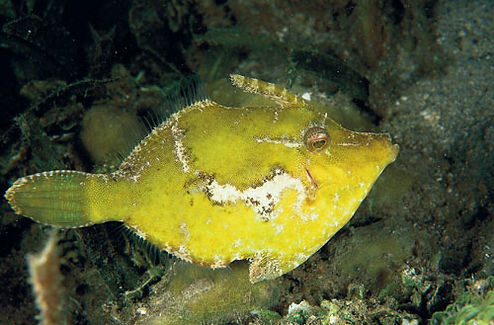
The longnose filefish (Oxymonacanthus longirostris) is a highly specialized species that only feeds on small-polyped stony coral polyps.. Photo by Scott W. Michael
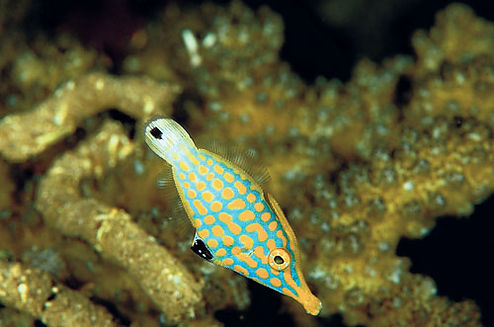
You must not bother your filefish during the acclimation process. This may mean targeting food into a preferred hiding place to ensure it gets enough to eat. These fish will often adapt to aquarium life more readily if their tank is not in a high traffic area.
The commonly kept Pervagor species can be housed in tanks as small as 55 to 70 gallons as adults. However, the adults of the larger filefish species (e.g., Cantherhines spp.) will need to be kept in tanks of 180 gallons or larger. Be aware that most of the larger species can grow quite rapidly. For example, a juvenile tasseled filefish () may do quite well in a 20-gallon tank, but it will rapidly increase in size and need a tank of at least 100 gallons when it reaches adult size (close to 12 inches long). When it comes to size, avoid juvenile scrawled filefish (Aluterus scriptus). Although beautiful fish, they can reach a length of 3 feet.
-Chaetoderma pencilligera :
There are also miniature filefish that are unfortunately not readily available in the aquarium trade. For example, members of the genera Brachaluteres and Rudaris reach a maximum length of around 2 inches. Although shy, these smaller species would be wonderful for small tanks (20 gallons).
One major concern with filefish is providing enough for them to eat. Filefish are naturally laterally compressed (when seen head-on, they look thin), but captive specimens are often emaciated. This is evident when you look at the stomach and along the back of the fish. In an underfed individual, the stomach will be pinched in, as will the dorsum (the back or dorsal musculature), due to atrophied muscle tissue. The latter is evidence of more long-term starvation.
These fish feed almost continuously in the wild and should be fed numerous small meals in the aquarium (three times a day at minimum). Younger fish have greater metabolic needs and will require even more food than adults. Of course, in the case of many filefish species, juveniles are sold in the aquarium trade.
It’s important that any filefish diet contains plant material. This may include frozen preparations that contain algae, algal flake foods and dried algae sheets (nori). A tank with some filamentous and macroalgae can also be useful in helping to supply their nutritional needs, especially for a specimen that is reluctant to accept introduced fish foods. Meaty foods, such as fresh seafood shavings, frozen mysid shrimp, frozen preparations and flake foods, should round out the diet.
Filefish certainly have the dentition to damage both stony and soft corals, and as noted, some regularly include these in their diets. That said, filefish have been housed in reef tanks without damaging their coral neighbors. In fact, some filefish may be used to help control pestilent invertebrates, such as the Majano anemone, in a reef tank. The sea grass filefish ( will feed on and remove Majano populations, as well as Aiptasia (they usually feed on the latter first, then move on to the former). However, be warned that when they run out of these small sea anemones, they may begin feeding on your more desirable corals, including Xenia corals, leather corals (they pick at Sarcophyton polyps) and large-polyped stony corals. That said, I have seen beautiful reef tanks with healthy soft and stony corals that contained one of these filefish.
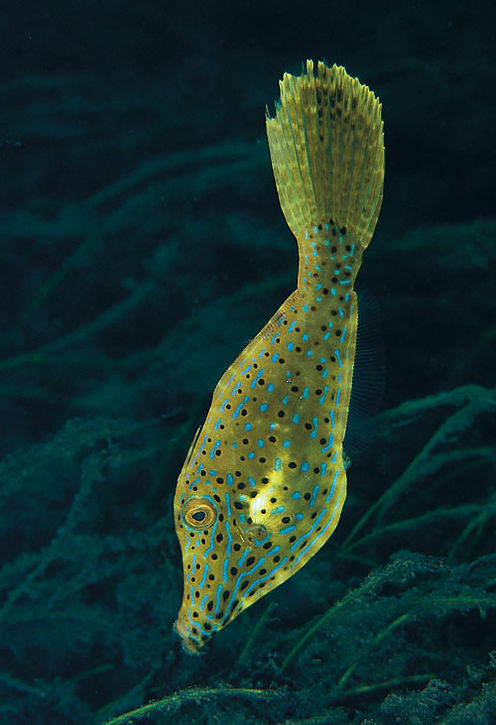
The scrawled filefish (Aluterus scrptus) can be kept as a juvenile but will eventually outgrow most home aquariums. Photo by Scott W. Michael
If you decide to try a filefish in your reef tank, know that there is an inherent risk to corals. They have the ability and natural propensity to feed on sessile invertebrates. Remember that a hungry filefish is more apt to stray, so feed it well. Without question, the exquisite longnosed filefish will eat the polyps of some stony corals. Yet because of its highly specialized diet and poor track record when it comes to captive survival, it is best left on the reef, anyway. Other ornamental invertebrates that may be accosted by these fishes include polychaete worms (including tube worms), shrimps, small crabs, serpent stars, sea urchins and small sea cucumbers.
When it comes to fish neighbors, filefish tend to be rather benign. They usually do not bother any tankmates, with the possible exception of members of their own kind or close relatives. Although you can put two filefish of different species in the same tank, the aquarium should be large. The actual size is dependent on the species in question. So, for example, a Pervagor should have a tank of at least 135 gallons. Two filefish of the same species, especially of the same sex, are likely to duke it out.
On the other hand, filefish are sometimes picked on by larger angelfish, large damsels, surgeonfish and triggerfish. If a newly introduced filefish is the target of a belligerent tankmate, it’s likely to hide all the time and not eat.
Be careful when capturing and moving a filefish. Because they are so prickly, they have a tendency to get stuck in net mesh. It’s a better idea to herd the fish into a specimen container or shipping bag when removing it from a tank. The dorsal and pelvic spines (which are often adorned with smaller spines) are particularly prone to getting stuck in a net. If this happens, you may have to cut the mesh away from the spine with a scalpel. This process can be very stressful for the filefish (and probably for you, as well).
This ends our brief look at filefish. They are often overlooked but are truly worthy candidates for a live-rock-only fish aquarium and may be kept with some of the soft corals that are less desirable to eat. If you feed your filefish often, provide suitable hiding places and a peaceful setting, filefish should live for many years in your aquarium.
Aiptasia :
I have Aiptasia all over my tank and have been told I need to add a filefish.
By Scott W. Michael ... courtesy to : www.fishchannel.com
Q. I have Aiptasia all over my aquarium and have been told I need to add a filefish. I looked at your Reef Aquarium Fishes book and it does not recommend filefish for the reef aquarium. What should I do? Are filefish reef-safe? What about copperbanded butterflyfish?
Answer : A. A couple of years ago, I shared information about the bristletail filefish (Acreichthys tomentosus) in this column. I found that many European aquarists included this species in their reef aquarium fish communities to take care of both glass anemones (Aiptasia spp.) and the dreaded majano anemones (Anemonia cf. majano).
The European reefkeepers swore up and down that they did not harm other cnidarians in the aquarium. In this column, I suggested that there was some data that they may pick at xeniid corals, leather corals (they pick at Sarcophyton polyps) and large-polyped stony corals. Since that time, I have kept a dozen of these fish in my own aquariums and customers’ aquariums, and have found that they are not as trustworthy as I had hoped. Yes, they love to munch on those annoying little anemones that can take over an aquarium, but they also might nip at the tentacles of more desirable sea anemones, such as Entacmaea quadricolor, the tips of gorgonian branches and the fleshy polyps of a variety of large-polyped stony corals (e.g., Turbinaria, Lobophyllia, Trachyphyllia).
Is there a place for these filefish in the reef aquarium? Most definitely. They are still the best biological control I have found for clearing a aquarium of Aiptasia or majano anemones.
To give an example, I do aquarium maintenance, and a customer’s aquarium had been overtaken by glass anemones (some of the largestAiptasia I have ever seen). I added two A. tomentosus, and within a month, the number of Aiptasia greatly declined. After several months, there was not an Aiptasia to be found. I had tried peppermint shrimp in this
Though most Chelmon spp. can be kept in a reef aquarium, they will cause problems with some animals, such as Christmas tree worms, like this Spirobranchus giganteus.
The bristletail filefish (Acreichthys tomentosus) will clear a aquarium of Aiptasia or majano anemones. However, they will also nip at other sea anemones.

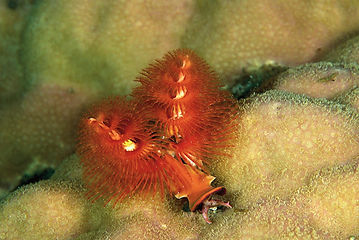
aquarium, Aeolidiella stephanieae and the so-called Berghia sea slugs. These anemone-eating inverts did little good in this anemone-infested aquarium, unlike our friend A. tomentosus. (This is not to say that some aquarists have not had luck getting these inverts to “take out” their anemone enemies, but they are less consistent in bringing Aiptasia, both large and small, under control like the bristletail filefish.) I also want to say that the bristletail filefish is the best biological control of majano sea anemones that I know of.
The ideal situation may be to remove the bristletail filefish once it has the pestilent sea anemones in check. Of course, this can be easier said than done. They are not that easy to catch with a fish trap (though some individuals may enter if you add a tasty treat, such as a piece of table shrimp or scallop), and trying to round up one of these secretive little guys in a aquarium full of live rock can be a real trick. The bottom line: adding a filefish to your reef aquarium is always a calculated risk.
Regarding copperbanded butterflyfish (Chelmon rostratus), they can sometimes be very effective at helping deal with Aiptasia outbreaks. That said, some individuals ignore glass anemones. Most individuals (and other members of the genus Chelmon) can be kept in a reef aquarium with most soft corals and small-polyped stony corals, though some individuals may nip at large-polyped stony corals, certain soft corals (including xeniids and clavulariids) and zoanthids. Christmas tree worms are also a potential target of Chelmon rostratus.
Another downside with Chelmon rostratus is that it can be quite delicate. Your chances of success will greatly increase if you’re selective about the specimen you add to your aquarium. Avoid emaciated individuals, unless you hope to try and rescue the fish. Unfortunately, thin individuals are not likely to recover.
Some aquarists have suggested that smaller individuals (around 3 inches in length) fare better in captivity than adults. The idea is that smaller individuals are more likely to acclimate to a new food source than an older conspecific. That said, be aware that the metabolic needs of a juvenile fish will be higher than that of an adult. Feed a young fish frequently or ensure there is an adequate natural food source present in the aquarium.
Copperbanded butterflyfish are thought to feed heavily on tubeworm feeding appendages and small crustaceans. A aquarium with live rock will provide some normal fodder. This will provide a hungry copperbanded with nutritional snacks between meals. Natural prey items are also important if a newly added Chelmon rostratus is reluctant to eat aquarium foods when first introduced to the aquarium.
Good luck with your Aiptasia problem. Remember that adding Aiptasia-eating fish to an aquarium containing corals is a calculated risk. But it is a risk many aquarists find worth taking. Happy fish watching!
Filefish: A bit of rough!
courtesy to : www.practicalfishkeeping.co.uk
They have skin like sandpaper and can be fascinating and entertaining masters of disguise. Dave Wolfenden spotlights the filefish.
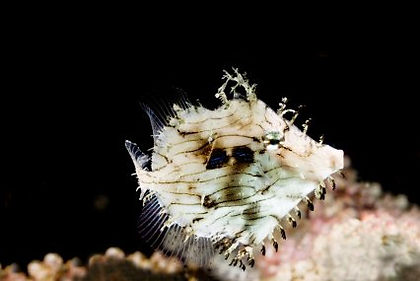
One of the most overlooked groups of fish in the marine hobby has to be the filefish. Many believe them too sensitive to be maintained successfully and some species are definitely unsuitable for aquarium life. Yet several are worth considering, providing you know their requirements and are aware of potential pitfalls.
Filefish, also known as the leatherjackets, closely resemble triggers and puffers, with features common to both groups.
In fact, these fish are all in the same order, belonging to the Tetraodontiformes.
The filefish family name Monacanthidae — meaning one spine — is derived from the prominent dorsal spine that’s used to wedge the fish into crevices, triggerfish style.
Filefish have an unusual scale morphology, in which setae (or spines) are present. These give the fishes’ skin a particularly rough texture, hence the name.
Filefish skin was reportedly once used as a substitute for sandpaper and if you’ve ever held one in your hands you’ll understand why.
Choose wisely :
Filefish can be hardy, but choose specimens already allowed to settle after the stresses of transport. I’d always want to see one feeding before purchasing.
It can be difficult to initially tell if an animal is emaciated due to their characteristic laterally compressed body shape, but any with a noticeably pinched abdomen might spell trouble.
A period of quarantine should allow the fish to settle into long-term captive life and adapt to a variety of foods before being added to the main aquarium.
Health problems are not generally a major issue, although obviously the usual parasitic diseases may arise. The viral disease Lymphocystis is sometimes seen soon after introduction on newly acquired specimens, but this will clear up spontaneously if water quality and diet are optimal.
Aquarium life :
In terms of lifestyle, these fish tend to use stealth, crypsis, mimicry and masquerade to avoid detection and predation, so replicate their habitat as closely as possible. Lots of rockwork with plenty of crevices, nooks and crannies are ideal.
Are filefish reef safe? Bearing in mind that these are mainly opportunistic feeders on a variety of invertebrates, with some species specifically feeding just on coral polyps, they’re risky in reef aquaria.
If going to add a one to a mixed fish/invertebrate system, accept that some inverts may be eaten. While some enthusiasts successfully maintain filefish in invertebrate systems, I’d be wary of adding one to a reef.
On balance, a Fish Only With Live Rock (FOWLR) system is perfect for these fish. Tank mates should be non-aggressive, as overly boisterous species will not only harass filefish but may also out-compete them for food. That includes large angels, big puffers and large triggers.


Feeding : (picture above of Acreichthys tomentosus by Haplochromis, Creative Commons)
Most, but by no means all, species are easy to feed, thanks to their mainly catholic tastes. Omnivorous filefish will graze the biofilm of algae and invertebrates from the reef’s rock, as well as consuming sponges, sea squirts, anemones, gorgonians, worms and molluscs, plus other fare.
Variety in captivity is therefore important and regular two, three or more daily feeds are recommended. Live rock will go some way to stimulating natural foraging behaviour and providing food items, and this should be augmented with fresh and frozen feeds. Mysis, mussel meat, Artemia, it’s worth trying all of them.
However, there are exceptions — specifically the Harlequin filefish (Oxymonacanthus longirostris) — which, along with others of the genus, is an obligate corallivore and unsuited to life in the aquarium.
Choose from six of the best…
The Blacksaddled leatherjacket (Paraluteres prionurus) — pictured above — from the Indo-Pacific and which grows to 10cm/4” is fascinating. It mimics the toxic Valentini puffer (Canthigaster valentini) — pictured below — hence the alternative name of False puffer.
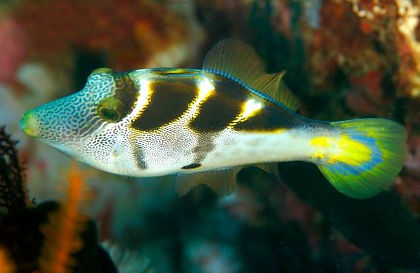
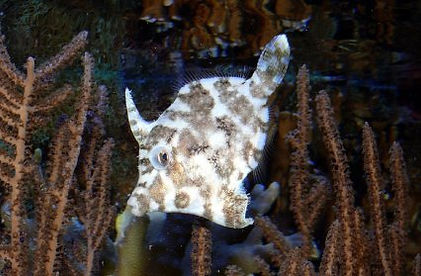
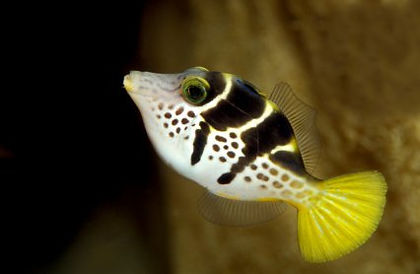
P. prionurusis among the toughest filefish and its mimicry is really interesting. I’ve kept both mimic and true puffer together in a public aquarium and this can work well, provided there’s enough room for both of them.
The Tasselled filefish (Chaetodermis penicilligerus) — pictured at the top of the page — comes from the Indo-Pacific and looks bizarre. Growing to 20cm/8” in captivity, possibly more, this cryptic filefish sports weedy outgrowths over the body with disruptive coloration serving to disguise the animal. Despite its delicate looks, this is a hardy species benefitting from regular feeds.
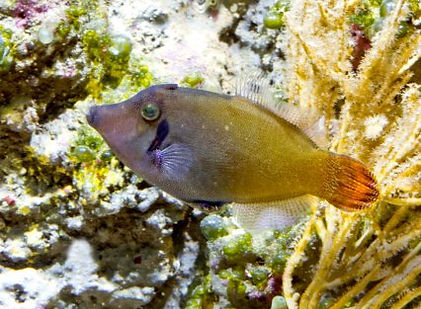
The Hawaiian orange-tail filefish (Pervagor spilosoma) is recommended only for experienced aquarists. Hailing from the Eastern Pacific, especially around Hawaii, this occasionally-imported species can be delicate and difficult to get feeding. However, once trained to accept prepared foods, it should do well in the aquarium.
Coloration is interesting, with a mottled body and red fan-shaped tail. Expect adults to reach 15cm/6” in the aquarium.
From the same genus, it’s not hard to see why the Flame filefish (P. melanocephalus) gets its common name. Having a length of up to 15cm/6” and originating from the Indo-West Pacific, this species sports a black head, but a bright red rear half. This is another species for seasoned aquarists, as feeding can be problematic.
Sexing is possible among adults, with males possessing more prominent spines at the base of the tail, along with an orange patch just in front of these spines.


The so-called Aiptasia-eating or Bristletail filefish (Acreichthys tomentosus) from the Indo-West Pacific is now top of many wish lists, thanks to its wonderful habit of munching on Aiptasia and Majano anemones.
This new kid on the block, which grows to 12cm/4.8”, is a cryptic species, ranging from brown to green, allowing it to blend with the vegetation of its environment. It’s not stunning by any stretch, but its unusual appearance compensates for its drab coloration.
They tend to more commonly frequent seagrass and mud habitats — not traditionally regions exploited by ornamental fish collectors. Recently, however, collectors have tried to capitalise on demand and it’s now pretty widely available.
To sex this species, look for a patch of prominent setae around the caudal peduncle (tail base) of an adult — the presence of which identifies a male.
However, beware of imitations as several species with a similar appearance appear frequently sold under the same common name, although it’s hit and miss how effective these misidentified specimens are at anemone control.
Despite the name, even true Aiptasia-eating filefish don’t feed exclusively on pest anemones. So be cautious as it’s possible that any specimen can feed on other polyps – including your prized SPS corals.

….but avoid
The Harlequin or Orange-spotted filefish (Oxymonacanthus longirostris) from the Indo-Pacific is truly stunning, displaying a psychedelic livery of orange spots on a bright green background. It’s also a specialist feeder, being an obligate corallivore feeding exclusively in the wild on SPS coral polyps — specifically Acropora.
This diet means this species is difficult to maintain long-term and I suspect that dismal survival rates are the norm.
Although some have maintained Harlequins by providing adequate Acropora, or by weaning them on to substitute feeds — and they have even been captive bred — success stories are rare.
Fair play to those keeping them, but this 12cm/ 4.7” filefish is best left, if only because of its poor captive survivability.
There may be additional issues too. Populations, already under pressure from coral bleaching, may be nudged closer to local extinction by collection for the trade.
Predators are fooled by coral disguise
O. longirostris’ coloration is believed to be used to mimic the appearance of Acropora branches among which it lives.
It feeds diurnally (during the day), but at night it has been seen head down, wedged in place with its dorsal spine.
The fish’s behaviour, spotted coloration and even the pale tip of the caudal fin, appear adaptations in resembling its coral habitat. Biologists refer to this as masquerade — looking like another organism to misdirect potential predators.
Can I breed any filefish species?
It’s possible to maintain a pair of filefish if you have the room.
Many species will exhibit sexual dimorphism and/or dichromatism as adults — in other words, male and female displaying varying size or morphology (dimorphism) or coloration (dichromatism).
Juveniles, however, are generally monomorphic, that means having a similar appearance between the sexes.
Filefish are egg depositors too, which adds to the ease with which you can collect the fry.
Add to this the fact that newly-hatched filefish fry are of a relatively large size — making Artemia nauplii a suitable first food for them.
A good first species to try out would be Aiptasia-eating filefish (Acreichthys tomentosus), which has already been successfully raised by several breeders in captivity.
Don’t lift in nets
The rough skin of filefish, with its prickly setae, can become entangled in fine-mesh nets, which can lead to tangling and potential trauma when handling. It’s less risky to use a net simply for manoeuvring the fish, then using a beaker or bucket to capture it.
Many filefish are small, but…
Despite the diminutive size of many filefish, some species can attain large adult sizes, so research any potential purchase and ensure positive ID.
The Scribbled filefish (Aluterus scriptus) is found in all tropical oceans and is the largest of the family. Growing to just over 1m/3.3’ in length, it’s an awesome sight and definitely best left to public aquariums.
Why not take out a subscription to Practical Fishkeeping magazine? See our latest subscription offer.
Don't forget that PFK is now available to download on the iPad.

Filefish species :
Most Filefish grow to around six inches and feed on algae and crustaceans. Filefish do extremely well in captivity and make ideal candidates for the average home aquarium. Provide Filefish with adequate hiding places and ample swimming space.
1-Matted Filefish
Acreichthys tomentosus
Minimum Tank Size: 30 gallons
Care Level: Moderate
Temperament: Peaceful
Reef Compatible: With Caution
Water Conditions: 72-78° F, dKH 8-12, pH 8.1-8.4, sg 1.020-1.025
Max. Size: 3½"
Color Form: Green, Tan
Diet: Omnivore
Compatibility: View Chart
Origin: Indonesia
Family: Monacanthidae
The Matted Filefish is also known as the Bristletail Filefish, Matted Leatherjacket, Tomentosus Filefish, or Aiptasia Eating Filefish. The body is a mottled green, brown, and tan coloration.
It is a shy fish, and rarely aggressive towards other fish except those of its own genus. It is best suited for aquariums 30 gallons or larger that does not contain small invertebrates.
The Matted Filefish is known to eat Aiptasia anemone in the home aquarium, but normally nips at soft and stony corals as well. The diet should include shaved shrimp, squid, scallop, mysis shrimp, freeze-dried krill soaked in a vitamin supplement, and frozen marine algae. The Matted Filefish should be fed small quantities of food several times per day.
These fish have been known to spawn in captivity, and males are normally large than the females, having fine bristle-like hairs on each side of their body down the caudal peduncle or base of the tail.
Approximate Purchase Size: Small: 1-1/2" to 2"; Medium: 2" to 2-3/4"; Large: 2-3/4" to 3-1/2"
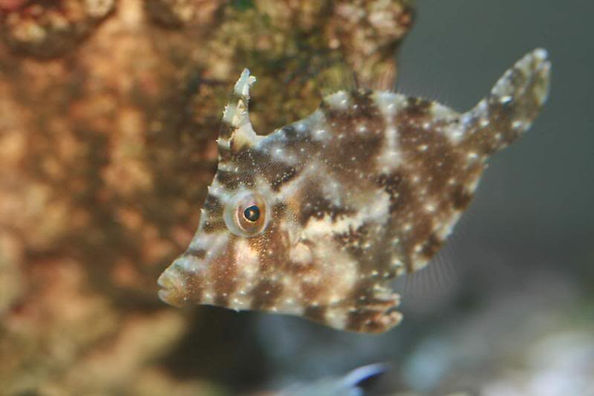
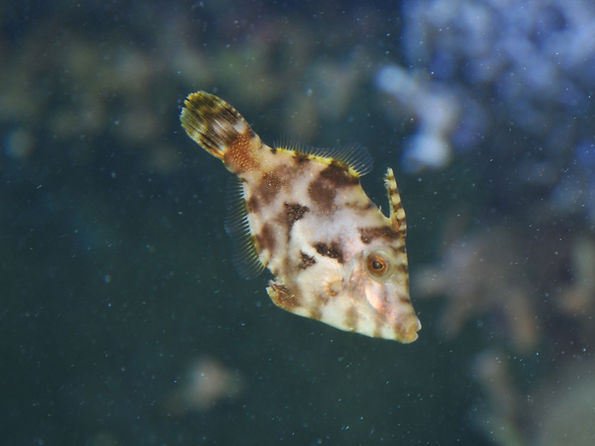
2-Colored Filefish
Pervagor melanocephalus
Minimum Tank Size: 30 gallons
Care Level: Moderate
Temperament: Peaceful
Reef Compatible: No
Water Conditions: 72-78° F, dKH 8-12, pH 8.1-8.4, sg 1.020-1.025
Max. Size: 4"
Color Form: Black, Orange, Red
Diet: Omnivore
Compatibility: View Chart
Origin: Cebu, Fiji
Family: Monacanthidae
The Colored Filefish is also known as the Blackheaded Filefish. The body is orange to red in color and the head can be gray to black. Filefish from Hawaii tend to have more vivid colors than those from the Indian Ocean.
It is a shy fish, and rarely aggressive towards other fish except for those of its own genus. It is best suited for aquariums 30 gallons or larger that do not contain invertebrates.
The Colored Filefish may be difficult to feed initially; it may be beneficial to imbed shrimp into coral, and allow the fish to feed off of the coral. The diet should include shaved shrimp, squid, scallop, mysis shrimp, freeze-dried krill soaked in a vitamin supplement, and frozen marine algae. The Colored Filefish should be fed no fewer than three times a day.
Approximate Purchase Size: Small: 1" to 2" Medium: 2" to 3" Large: 3" to 4"


3-Tassle Filefish
Chaetodermis penicilligerus
Minimum Tank Size: 180 gallons
Care Level: Easy
Temperament: Peaceful
Reef Compatible: No
Water Conditions: 72-78° F, dKH 8-12, pH 8.1-8.4, sg 1.020-1.025
Max. Size: 1'
Color Form: Green
Diet: Omnivore
Compatibility: View Chart
Origin: Indo-Pacific
Family: Monacanthidae
The Tassle Filefish, also known as the Leafy Filefish or Prickly Leatherjacket Filefish, is camouflaged by its light body with dark horizontal stripes.
It is best suited for a 180 gallon or larger aquarium with weedy areas, rocks, and at least one suitable shelter. It is a peaceful fish that does not bother fish tank mates, with the exception of members of its own family or related kinds.
The Tassle Filefish feeds on a diet of meaty foods including chopped shrimp, squid, clams, fish, and frozen algae and vitamin enriched foods. It should be fed no fewer than three times per day.
Approximate Purchase Size: Small: 1" to 2"; Medium: 2" to 3"; Large: 3" to 4"
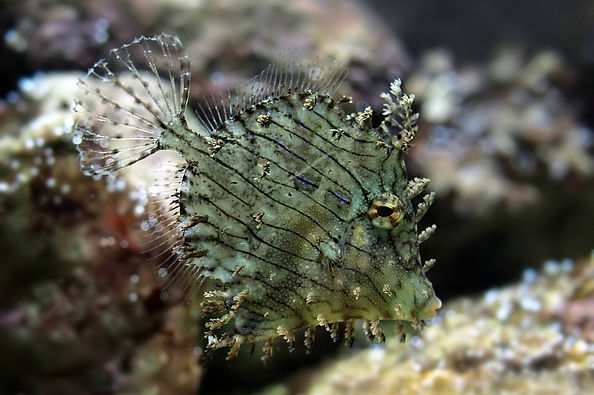

4-Orange spotted filefish
Oxymonacanthus longirostris
From Wikipedia, the free encyclopedia
The orange spotted filefish or harlequin filefish, Oxymonacanthus longirostris, is a filefish in thefamily Monacanthidae found on coral reefs in the Indo-Pacific Oceans. The orangespotted filefishis a different species and refers to Cantherhines pullus.
The orange spotted filefish is pale blue with about eight longitudinal rows of orange-yellow patches. In the wild it feeds almost exclusively on Acropora polyps
- In the aquarium:
They are often offered for sale in the aquarium trade, but few survive long in captivity.[3] They are difficult to maintain in an aquarium unless provided with live corals. They must be kept in species-specific tanks, or tanks with very passive tankmates such as seahorses or pipefish. They have been successfully bred in captivity.
-In the wild:
Orange spotted filefish absorb and use chemicals in the Acropora coral they eat to take on its smell, which cloaks them from natural predators like cod. In addition to this trait, not observed among othervertebrates, they also use visual camouflage
Study reveals orange-spotted filefish have VERY selective coral diet..
By Leonard Ho - Posted Aug 05, 2014 09:00 AM @ www.advanced aquarist . com
The orange-spotted filefish/harlequin filefish is one of the most beautiful, weirdly shaped and colorful reef fish available to marine aquarists. Once thought of as strict coral-eaters, bold reefkeepers have attempted this species in reef tanks with mostly positive experiences. A new research may explain why.
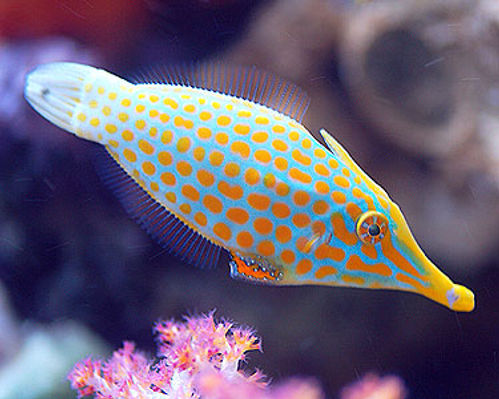
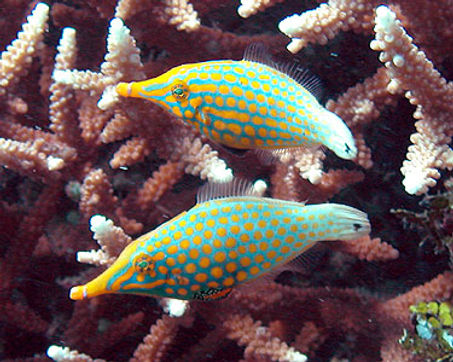
Oxymonacanthus longirostris, AKA the orange-spotted filefish or harlequin filefish, was once thought of as a definite no-no for reef aquariums. Filefish and corals simply can't mix.
Or can they?
In recent years, several aquarists who could not resist this species' allure (and some inspired by the success of Dr. Sanjay Joshi) have attempted to keep these filefish in their heavily stocked reef aquariums. Two surprising observations are often reported:
1-These filefish can be weaned (sometimes easily) unto prepared aquarium foods such as mysis, brine shrimp, gel-based foods, et al.
2-O.longirostris leave corals alone for the most part, only occasionally nipping on a few corals especially when the fish are not regularly fed.
So why is it that orange spotted filefish, once believed to be obligate corallivores, don't devastate reef tanks like aquarist once feared? Science may give us some insight.
While we long known these filefish to exhibit a strong dietary preference for Acropora millepora, researchers studying reefs after coral bleaching events discovered that Oxymonacanthus longirostris has an extreme preference for their favorite coral almost to the point of monophagy (only tolerant of one type of food). The orange-spotted filefish would still attack bleached A.millepora even if healthy corals of other species remained high. In coral communities where A.millepora has died out, this study concludes that the dietary preference is so strong that O.longirostris may choose to starve to death instead of eating other corals.
Orange-spotted filefish appear to be reef safe with caution, but not if you like keeping Acropora millepora. Questions still remain about the long-term viability of weaning highly specialized feeders onto different foods and why these picky feeders in nature will adopt novel foods in captivity.
The paper is published in the scientific journal Coral Reefs.
Oh, for those interested in why these tilefish look the way they do, check out this amazing camouflage:
www.advancedaquarist.com/blog/harlequin-filefish-masquerading-as-its-prey
